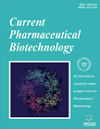- Home
- A-Z Publications
- Current Pharmaceutical Biotechnology
- Previous Issues
- Volume 17, Issue 14, 2016
Current Pharmaceutical Biotechnology - Volume 17, Issue 14, 2016
Volume 17, Issue 14, 2016
-
-
Antitumoral Potential of Snake Venom Phospholipases A2 and Synthetic Peptides
More LessCancer, a disease that currently affects approximately 14 million people, is characterized by abnormal cell growth with altered replication capacity, which leads to the development of tumor masses without apoptotic control. Resistance to the drugs used in chemotherapy and their side effects stimulate scientific research seeking new therapies to combat this disease. Molecules from flora and fauna with cytotoxic activity agains Read More
-
-
-
Cell Proliferation and Cytotoxicity Assays
More LessAuthors: Aysun Adan, Yagmur Kiraz and Yusuf BaranCell viability is defined as the number of healthy cells in a sample and proliferation of cells is a vital indicator for understanding the mechanisms in action of certain genes, proteins and pathways involved cell survival or death after exposing to toxic agents. Generally, methods used to determine viability are also common for the detection of cell proliferation. Cell cytotoxicity and proliferation assays are generally used for drug scr Read More
-
-
-
Time-Resolved Fluorescence Resonance Energy Transfer [TR-FRET] Assays for Biochemical Processes
More LessAuthors: Ekin Ergin, Arin Dogan, Mahmut Parmaksiz, Ayse E. Elcin and Yasar M. ElcinTime-Resolved Fluorescence Resonance Energy Transfer (TR-FRET) is a fluorescence based technique which enables the analysis of molecular interactions in biochemical processes. Principle of TR-FRET is based on time-resolved fluorescence (TRF) measurement and fluorescence resonance energy transfer (FRET) between donor and acceptor molecules. To generate FRET signal, donor and acceptor molecules must show spec Read More
-
-
-
Design, Synthesis, and Evaluation of Heat Shock Protein 90 Inhibitors in Human Breast Cancer and Its Metastasis
More LessAuthors: Mehmet Gümus, Aykut Ozgur, Lutfi Tutar, Ali Disli, Irfan Koca and Yusuf TutarBackground: Despite development of novel cancer drugs, invasive ductal breast carcinoma and its metastasis are still highly morbid. Therefore, new therapeutic approaches are being developed and Hsp90 is an important target for drug design. For this purpose, a series of benzodiazepine derivatives were designed and synthesized as novel Hsp90 inhibitor. Methods: Benzodiazepine derivatives anticancer activities were dete Read More
-
-
-
A New Era for Cancer Target Therapies: Applying Systems Biology and Computer-Aided Drug Design to Cancer Therapies
More LessAuthors: Yung-Hao Wong, Chia-Chiun Chiu, Chih-Lung Lin, Ting-Shou Chen, Bo-Ren Jheng, Yu-Ching Lee, Jeremy Chen and Bor-Sen ChenIn recent years, many systems biology approaches have been used with various cancers. The materials described here can be used to build bases to discover novel cancer therapy targets in connection with computer-aided drug design (CADD). A deeper understanding of the mechanisms of cancer will provide more choices and correct strategies in the development of multiple target drug therapies, which is quite different fro Read More
-
-
-
Aerosol Delivery Devices for the Treatment of Adult Patients in Acute and Critical Care
More LessAuthors: Arzu Ari and James B. FinkAerosolized medications are commonly used for the treatment of patients with pulmonary diseases in acute care. While there are many drug/device combinations available on the market, new devices have been developed in the past few years. Due to differences in their operation, performance and requirements for proper use, it is important to know how to use these aerosol devices effectively during inhalation the Read More
-
-
-
Evaluation of Antioxidant Activity of Phytol Using Non- and Pre-Clinical Models
More LessBackground: Phytol (3,7,11,15-tetramethylhexadec-2-en-1-ol; PHY), the alcoholic diterpenoid is particularly interesting due to its diverse activities found in literature. This study evaluated in vitro and in vivo antioxidant capacity of PHY. Methods: We conducted DPPH• (2,2-diphenyl-1-picrylhydrazyl) and ABTS•+ (2,2'-azino-bis(3- ethylbenzthiazoline-6-sulphonic acid)) radical scavenging tests as in vitro, while Saccharom Read More
-
-
-
Bio Fabrication of Silver Nanoparticle from Argemone mexicana for the Control of Aedes albopictus and their Antimicrobial Activity
More LessBackground: Plant synthesized silver nanoparticles give rapid control on mosquito larvae of dengue vector, Aedes albopictus. AgNPs synthesized from the plant, Argemone mexicana for the control of larvae and these nanoparticles inhibit the growth of microbes are broad spectrum of nanoparticle activities. Methods: Nanoparticles were subjected to analysis by UV-vis spectrophotometry, Fourier transform infrared spec Read More
-
Volumes & issues
-
Volume 26 (2025)
-
Volume 25 (2024)
-
Volume 24 (2023)
-
Volume 23 (2022)
-
Volume 22 (2021)
-
Volume 21 (2020)
-
Volume 20 (2019)
-
Volume 19 (2018)
-
Volume 18 (2017)
-
Volume 17 (2016)
-
Volume 16 (2015)
-
Volume 15 (2014)
-
Volume 14 (2013)
-
Volume 13 (2012)
-
Volume 12 (2011)
-
Volume 11 (2010)
-
Volume 10 (2009)
-
Volume 9 (2008)
-
Volume 8 (2007)
-
Volume 7 (2006)
-
Volume 6 (2005)
-
Volume 5 (2004)
-
Volume 4 (2003)
-
Volume 3 (2002)
-
Volume 2 (2001)
-
Volume 1 (2000)
Most Read This Month
Article
content/journals/cpb
Journal
10
5
false
en


